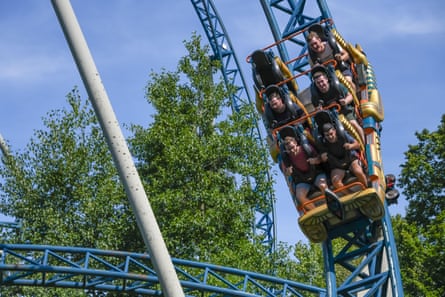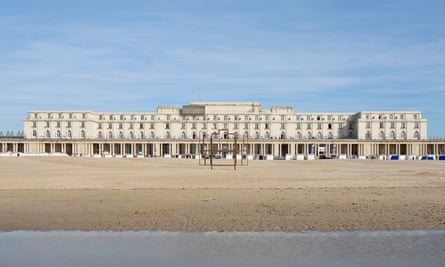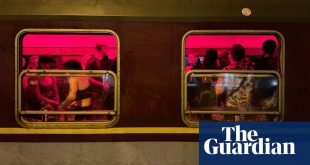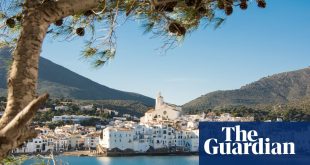I have a confession to make. I really love Belgium. This is, I know, not something travel writers often admit. But Belgium always packs surprises and never more so than on the coast, with its seductive dunescapes, art nouveau villas, gothic town halls, geometric art deco, and heaps of modern concrete. High-rise apartment blocks often threaten the dunes, but the 65km sweep of the Belgian coast from the Dutch border to the French one is full of interest.
Back in the late 19th century, Belgium was in the throes of railway mania. The mainline network was well-established and there was a developing maze of narrow-gauge railways. In 1885 the first sections of an ambitious new route opened: when completed, it ran the length of the Belgian coast. It’s still in service today, the only significant survivor of a network that in 1945 boasted more than 2,800 miles of light railways and urban trams. It’s the longest tram line in the world.
153 minutes of cinema
Riding the rails from De Panne in the south-west to Knokke, close to the Dutch border, is pure cinema. It is a 153-minute visual feast on a line that is now operated as a tramway, the Kusttram. In The Kingdom by the Sea, Paul Theroux came to terms with Britain by exploring its coastline. An end-to-end ride on the coastal line is one way of coming to terms with modern Belgium.
I plan to set off mid-morning from the “French” end of the line and stop off here and there along the way. Armed with a one-day pass for just €7.50, I hop on a comfortable, modern tram at De Panne. First stop is Plopsaland, where gnomes wait in attendance by the entrance of the theme park after which the station is named.

All Belgian life is captured in the run along the coast, from those gnomes at Plopsaland to a thousand tearooms where pensioners linger for hours over a single coffee or Leffe beer. Kings, mainly called Leopold and occasionally Albert, make cameo appearances in showpiece monuments. The backdrop changes dramatically by the minute: one moment a feast of classical colonnades, then piles of containers arranged like avant garde art as the tram skirts docklands and industrial estates.
As our tram pitches and rolls along the coast, I wonder why this route isn’t widely hyped as a wonderfully eclectic journey. Belgium just isn’t fashionable; yet tucked away along its coast are some quite remarkable spots. The entire route is an essay in surrealism, with René Magritte’s magnificent murals in the casino in Knokke, giant bananas dangling from flagpoles along the coast, piers that lead nowhere and sedate belle époque hotels that have had their sea views obliterated by apartment blocks. Bay windows that once boasted displays of orchids and calla lilies now survey concrete-and-glass blocks, which stand between them and the sand dunes and sea beyond.

Yet there is a quiet beauty in this architectural madness. The dunes may have been sacrificed to high-rise passions, but some perspectives are simply stunning. I stop off in Ostend and stroll east from the terrace of the Thermae Palace Hotel towards the port. There are graceful arcades, the inevitable statues of one Leopold or another, and then the pleasing curves of the casino. This is a town that once affected to be the Monte Carlo of the north. It is not for nothing that the square on the landward side of the casino is called Monacoplein. Too bad that the one-time ferry port, for so long the gateway to the continent for generations of British passengers, is no longer used by any passenger ferries.
after newsletter promotion
Seaside style at De Haan
Next stop is De Haan, easily the most attractive of the communities along the coast. Until the rails arrived De Haan was a poor seaside village of shrimp fishermen and their families. It was just a scattered collection of huts, regarded by neighbouring villages as the haunt of scoundrels and thieves. Within a few years of the arrival of the tram, De Haan had developed into an art colony and select resort – one that was later to number Albert Einstein among its visitors.
In De Haan the tram sits gracefully at the heart of the village, in a showpiece art nouveau tram station surrounded by fine cafes. I opt for the Beaufort tea room, in a decadent villa right by the tram line. No one in De Haan now relies on sea fishing for a living, yet reminders of the sea are everywhere – the Beaufort is named after the Irish sea captain whose wind force scale grades the power of the elements. Families sit for hours by the window, consuming unhealthy quantities of cake.

I hop on and off the tram without a plan. In many cases, it’s merely the placename that suggests a stop might be in order. I pause at Preventorium. This one-time isolation hospital has its own tram stop, though it seems that only rarely does anyone board or alight. Most of the 200 places in the Zeepreventorium clinic are now occupied by obese teenagers who are trying to come to terms both with themselves and with a society that now and again offers one waffle too many. The buildings are tucked away behind the dunes, out of sight and out of mind.
A little later, I stop at Manitoba. No mounties, no moose, no maple syrup. But a gentleman waiting for the tram down to De Haan explains that the area was named in honour of the Manitoba Dragoons, who in 1944 liberated the area from German occupation.
From Manitoba we rattle up towards the Dutch border, sometimes on lines laid in cobbled streets, slipping past gardens and factories to Knokke, with its brash beach bars and sedate art galleries. Here the rails give out, so I alight from the tram and walk on to the Dutch border.
Travel facts
The Kusttram service is operated by De Lijn and departs every 15 minutes during the day, less frequently in the evenings, and every 10 minutes at peak times in summer. A change of tram in Ostend is necessary on many journeys. A one-day pass (€7.50 for over-12s/€4 for 6-11s) allows unlimited travel and breaks in the journey. A three-day pass costs €15/€8. Purchase at ticket machines before boarding.
There are good rail connections from Brussels and other Belgian cities to De Panne and Knokke. Ostend, 90 minutes by fast train from Brussels, is at the mid-point of the Kusttram.
Nicky Gardner is the editor of Hidden Europe magazine and the co-author of Europe by Rail: The Definitive Guide, available from Guardian Bookshop
 Top Naija News: Nigerian News, Breaking News Nigeria and World News Top Naija News is a daily news publication in Nigeria, delivering the latest breaking news in Nigeria and around the world.
Top Naija News: Nigerian News, Breaking News Nigeria and World News Top Naija News is a daily news publication in Nigeria, delivering the latest breaking news in Nigeria and around the world.



